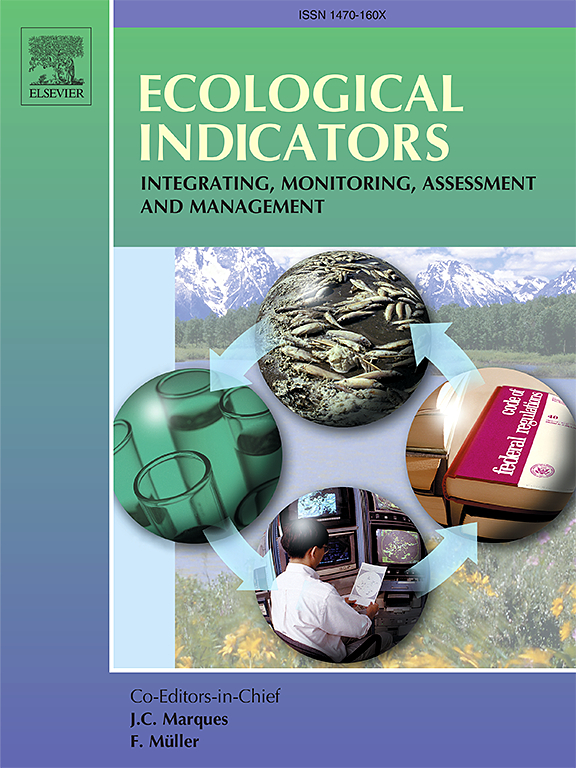Recent lake surface dynamics in the Hunshandake sandy land (2017–2022) and their response to climatic factors
IF 7
2区 环境科学与生态学
Q1 ENVIRONMENTAL SCIENCES
引用次数: 0
Abstract
Lakes, as critical components of the terrestrial water cycle, play an indispensable role in maintaining ecological balance, particularly in arid ecosystems like the Hunshandake (Otindag) Sandy Land (HSDK) of China. Understanding the spatiotemporal dynamics of these lakes is essential for deciphering regional hydrological cycles and predicting their ecological evolution in water-stressed environments. Leveraging the Google Earth Engine (GEE) platform and Sentinel-2 satellite imagery, we mapped the monthly water extents of lakes in the HSDK (2017–2022) at 10 m spatial resolution and analyzed their drivers. Key findings include: (1) Three classification approaches — pixel-based random forest (RF), object-oriented random forest (OB-RF), and support vector machine (SVM) — achieved high accuracy (Overall Accuracy: 98.5 %, 97.4 %, and 98.4 %; Kappa Coefficients: 0.970, 0.946, and 0.967, respectively). Compared with seasonal lakes, permanent lakes exhibited superior extraction accuracy. Notably, the OB-RF method generated clustered artifacts when mapping small fragmented water bodies. (2) The annual maximum lake area in the HSDK fluctuated between 345.61 and 419.42 km2 2017–2022 (mean: 379.55 km2). Though seasonal lakes were more numerous, permanent lakes made up 70 % of the total area. Monthly variations revealed a three-phase pattern: a gradual decline from April to June, a marked expansion in July–September, and subsequent contraction in October. (3) Interannual lake area changes were positively correlated with precipitation (2017–2021, R2 = 0.80, p < 0.05), although anomalous expansion occurred in 2022 despite reduced rainfall, suggesting hydrological inertia. At the monthly scale, lake areas exhibited a significant one-month lagged response to precipitation (R2 = 0.61, p < 0.001), highlighting delayed hydrological feedback.

浑善达克沙地近期湖面动态(2017-2022)及其对气候因子的响应
湖泊作为陆地水循环的重要组成部分,在维持生态平衡方面发挥着不可或缺的作用,特别是在浑山达克沙地等干旱生态系统中。了解这些湖泊的时空动态,对于破解区域水循环和预测其在缺水环境下的生态演变至关重要。利用谷歌地球引擎(GEE)平台和Sentinel-2卫星图像,我们以10 m空间分辨率绘制了HSDK(2017-2022)中湖泊的月水范围,并分析了其驱动因素。主要发现包括:(1)基于像素的随机森林(RF)、面向对象的随机森林(obr -RF)和支持向量机(SVM)三种分类方法均取得了较高的分类准确率(总体准确率分别为98.5%、97.4%和98.4%;Kappa系数分别为0.970、0.946、0.967)。与季节性湖泊相比,永久性湖泊的提取精度更高。值得注意的是,OB-RF方法在绘制小的破碎水体时生成了聚类工件。(2) 2017-2022年湖区最大湖泊面积在345.61 ~ 419.42 km2之间波动,均值为379.55 km2。虽然季节性湖泊数量较多,但永久性湖泊占总面积的70%。月度变化呈现出三个阶段的模式:从4月到6月逐渐下降,7 - 9月明显扩张,随后在10月收缩。(3)年际湖泊面积变化与降水量呈正相关(2017-2021年,R2 = 0.80, p <;尽管降水减少,但2022年出现了异常扩张,表明水文惯性。在月尺度上,湖泊区域对降水表现出显著的一个月滞后响应(R2 = 0.61, p <;0.001),突出了延迟的水文反馈。
本文章由计算机程序翻译,如有差异,请以英文原文为准。
求助全文
约1分钟内获得全文
求助全文
来源期刊

Ecological Indicators
环境科学-环境科学
CiteScore
11.80
自引率
8.70%
发文量
1163
审稿时长
78 days
期刊介绍:
The ultimate aim of Ecological Indicators is to integrate the monitoring and assessment of ecological and environmental indicators with management practices. The journal provides a forum for the discussion of the applied scientific development and review of traditional indicator approaches as well as for theoretical, modelling and quantitative applications such as index development. Research into the following areas will be published.
• All aspects of ecological and environmental indicators and indices.
• New indicators, and new approaches and methods for indicator development, testing and use.
• Development and modelling of indices, e.g. application of indicator suites across multiple scales and resources.
• Analysis and research of resource, system- and scale-specific indicators.
• Methods for integration of social and other valuation metrics for the production of scientifically rigorous and politically-relevant assessments using indicator-based monitoring and assessment programs.
• How research indicators can be transformed into direct application for management purposes.
• Broader assessment objectives and methods, e.g. biodiversity, biological integrity, and sustainability, through the use of indicators.
• Resource-specific indicators such as landscape, agroecosystems, forests, wetlands, etc.
 求助内容:
求助内容: 应助结果提醒方式:
应助结果提醒方式:


